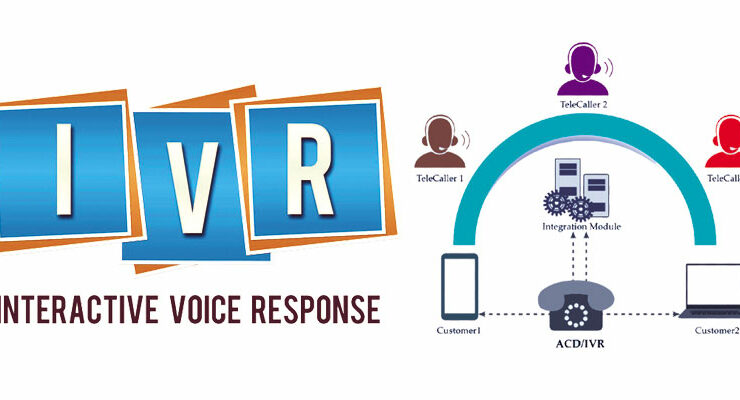
You’ve been on your phone for what appears to be hours, yet it’s only been five minutes. Finally, you are greeted by a synthetic voice. You solve your problems with the aid of that artificial voice after selecting from a menu of choices. This is only one example of an Interactive Voice Response function. It is a system, sometimes known as Interactive Voice Response (IVR), that lets callers communicate with the firm without being connected to an operator.
In this post, we’ll look at Interactive Voice Response (IVR) and what it is. We’ll also go through the advantages of IVR tools to help you determine if they’re suited for your business.
What exactly is Interactive Voice Response (IVR)?
IVR, or interactive voice response, is a function of an automated business phone system that engages callers and collects data by offering them alternatives via a menu. Based on the caller’s keypad or voice answer replies, it then takes appropriate action.
The IVR’s actions are determined by the caller’s choices; it can deliver information or, if the situation is more complicated, redirect callers to a human agent who can better manage their needs.
If you’ve ever dialed a company phone number and been greeted with an automatic greeting that then interacted with you via a pre-recorded message, you’ve encountered an IVR.
How does IVR Work?
Call centers and enterprises frequently employ interactive voice responses to route calls based on the selections made by the caller. Based on these choices, it may be possible to determine if the caller wants to speak with the billing division, the technical support group, or merely a human operator.
Additionally, it is used to distribute important information and instructions, such as promotions and updates. One illustration is telling callers that their calls will be recorded by the system and urging them to continue.
It had only ever been employed in the past to set up contact center lines. On the other hand, IVR systems have advanced significantly since their introduction and are now frequently used for the automation of straightforward tasks to provide callers with self-service options. This is to handle straightforward customer requests and inquiries that contact center agents would typically manage.
Check out: Top 30 Answering Services Providers For Busines
IVRs may currently perform the following processes:
- Inquire about the balance of your account.
- Account details may be accessed.
- Change passwords or set PIN numbers.
- Look up information (such as a product price or a directory).
- Completing lead forms and surveys
- Make modest payments or financial transfers.
Why Would a Company Use an IVR System?
Customers have traditionally sought assistance from customer service professionals in person (for example, at Apple’s Genius Bar) or over the phone by dialing a specific customer care number.
Customers can rely less on these physical encounters and more on self-service with the development of new technology such as Interactive Voice Response systems and the rising availability of online help resources such as FAQs or live chat options on a firm’s website.
What Is the Process of an Interactive Voice Response System?
A computer-telephony integration (CTI) system is an Interactive Voice Response system. A telephone board and specific IVR software that allows you to pre-record greetings for callers are required to implement IVR technology in your contact center. You may tailor these recordings to a specific caller’s requirements. When people call to purchase things from your organization, they will hear a different message than when they try to get into their accounts.
These interactive tools are designed to help end users navigate your contact center and rapidly discover an acceptable solution. When you call the firm as a customer, the IVR system will react by playing a pre-recorded greeting and asking you to select an option from a predetermined menu. For example, if you push “one” on the keypad, you will obtain a specific service.
This implies that consumers’ calls can be routed to the relevant parties for your team. Overall, fewer incoming calls, lower operating expenses, and better productivity for your team members result.
What are the advantages of IVR?
Adopting a new Interactive Voice Response function in your contact center may provide several benefits and advantages to your company.
Here are a few of the most common:
Better customer service
Nobody likes to waste time. But when someone calls a number, that is exactly what may occur. There is the lengthy hold time when waiting for a live agent, the incessant department switching, and the extended hold times because the agent isn’t fully equipped to address the issue.
Worst-case scenario: After all that, their anxiety is still unresolved.
Every stage of the IVR serves a purpose when it is constructed appropriately. Callers may either get the information they require via the IVR or have their needs identified so that the right person can connect with them right away.
Customers no longer need to contact the business again, which increases first contact resolution (FCR).
Clients will therefore think that dealing with your company is not a waste of their time or money.
The best systems provide you with a variety of alternatives for customizing your IVR interactions with callers since they are very customizable. This has individualized professional greetings that may be modified immediately.
When you combine it with your customer relationship management system, you may link personal information with the caller’s phone number or account number, and the IVR can address them by name.
Additionally, the Interactive Voice Response menu may be configured in a variety of languages, allowing callers to choose the one in which they feel most at ease.
There are so many possibilities.
Helps you come across as more professional
IVR systems used to be excessively expensive. Even the gear and infrastructure needed to enable it are not included in it. Because of this, a lot of individuals continue to associate IVRs with high-end programs that only big businesses can use.
With the cloud, that is no longer the case.
The majority of cloud contact center systems now come with IVR as standard, and they are also less expensive than on-premise alternatives.
As a result, you may employ an enterprise-level IVR system to help you project a more professional image without going over budget, regardless of how big or small your business is.
increases agent performance and morale
IVR isn’t meant to take the place of human agents. It was developed to greatly simplify the job of your call center representative.
If an automated IVR answered many of the simpler queries, the number of calls handled by people would decrease.
Without a competent IVR, contact centers may get overrun with incoming calls, which might cause agents to receive calls they are ill-equipped to handle. Agents grow frustrated since they are at a loss for how to solve the client’s problems. Stress and sadness are caused by frustration. The next thing you know, you have unmotivated employees who are about to resign.
By answering simple questions, an IVR with the proper configuration may cut down on the number of calls that need to be handled by agents. To ensure that agents only get calls for which they are qualified, it also works in conjunction with the skill-based routing feature.
As a consequence, call center representatives are more effective, successful, and content.
24/7 Service
The best feature of IVR is that it doesn’t need people to work. If not otherwise stated, it will continue operating after being programmed.
This means that it doesn’t need to sleep or relax, as humans do. Customers may call your business any time, day or night, and will be greeted by an automated message. It may even be able to complete tiny transactions, depending on how it is set up.
Decreases the frequency of manual errors
IVRs are automated, just like people, so they are not prone to errors. To handle incoming calls to your company, you might want to consider employing a professional receptionist.
Aside from the chance of being overburdened by high call volumes, manual call processing runs the danger of mistakes that direct calls to the wrong department or agent.
All calls in your contact center’s IVR system go logically in the sequence that has been predetermined in the phone menu. As a result, fewer personnel will need to use their judgment, which is ultimately to blame for many call-handling mistakes.
You can guarantee that every caller has the same IVR experience by automating your company’s call-handling process.



